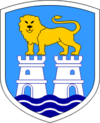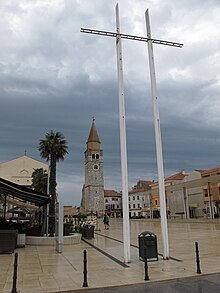Umag
|
Umag Umago |
|||
|
|||
|
|
|||
| Basic data | |||
|---|---|---|---|
| State : |
|
||
| County : |
|
||
| Height : | 0 m. i. J. | ||
| Area : | 83 km² | ||
| Residents : | 13,467 (2011) | ||
| Population density : | 162 inhabitants per km² | ||
| Telephone code : | (+385) 052 | ||
| Postal code : | 52 470 | ||
| License plate : | PU | ||
| Boat registration : | AROUND | ||
| Structure and administration (status: 2013, cf. ) |
|||
| Community type : | city | ||
| Mayor : | Vili Bassanese ( SDP ) | ||
| Postal address : | Ul. Giuseppe Garibaldi 6 52 470 Umag |
||
| Website : | |||
 View of Umag Umago |
|||
Umag (Italian Umago , German outdated: Humag , Latin Humagum ) is a small Croatian town with a port on the northwest coast of Istria in the Istria County , just a few kilometers from the Croatian-Slovenian border. It is a well-known business and tourist center and is 40 km from Trieste , 150 km from Ljubljana and 50 nautical miles from Venice .
From a tourist point of view, the hinterland of Umag is still unknown to many. It stretches between the Istrian rivers Dragonja and Mirna and is surrounded by the Savudrij Riviera , the Umag Riviera and the Novigrad Riviera.
The beaches in Umag and in the vicinity of the city are concrete slabs (Katoro, Punta), pebble beaches (Djuba, Stella Maris, Savudrija, Crveni Vrh) or sandy beaches (city beach Rita, Zambratija, Stella Maris / Monterol).
An ATP tennis tournament, the Croatia Open , has also been taking place in the Stella Maris district since 1990 .
history
The name Umag was first mentioned in the 7th century by an unknown citizen from Ravenna , but the city already existed in Roman times. This is supported by numerous Roman relics, such as a villa rustica , which were discovered all over the coast. The history of the town is closely linked to the settlement of Sipar , the ruins of which are located in a narrow sea six kilometers north of Umag. In the 9th century, the Sipar settlement was destroyed by invading Neretva pirates . Nevertheless, Umag continued to grow after this event, which is due to its island location, which is only separated from the mainland by a narrow channel. This strategic advantage enabled an effective defense of the island, and the numerous attacks could be repelled. After the Roman period, which was characterized by prosperity and growth, a period of uncertainty followed, triggered by constant attacks, but also epidemics such as malaria and cholera , which led to a sharp decline in population. Umag eventually became part of the kingdom of Odoacre , Theodoric and was also ruled by the Lombards .
From the 6th to the 8th century Umag came under Byzantine rule, later under that of the Lombards (751) and the Franks (774). Again, the rulers quickly alternated, including the patriarchs of Grado and Aquileia and then the bishops of Trieste . Later, with the rise of Venice , which wanted to control all of Istria , Umag and other cities had to pledge their allegiance to Venice. This happened in 1269, with the covenant lasting until 1797. Venice appointed noble residents as governors of Umag. However, that time was not peaceful.
The centuries-old dispute with Genoa brought suffering and destruction to the city. The Genoese sea power attacked the city in 1370 and destroyed the city archive. In the period that followed, epidemics caused the population to decrease again, which prompted the rulers in Venice to send settlers to the area. The main aim was to strengthen areas that were threatened by Turkish invasions. During the centuries of dependence on Venice, Umag's economy was dominated by agriculture. The port of Umag was used to ship agricultural products from the hinterland. Until the collapse of Venice, Umag was an ordinary Istrian town whose communal rule was guaranteed in the treaty of 1541.
With the end of the Republic of Venice, Umag and the entire eastern Adriatic coast became French . This only changed in 1815 when the area fell to Austria-Hungary until 1918 . According to the Austro-Hungarian census of 1900, Umag had 2,750 Italians, but no Slovenes or Croats. After the First World War , Istria became part of Italy . After the Second World War , the Free Territory of Trieste was introduced , with Umag becoming part of it and Zone B ruled by the Yugoslav army . Eventually Umag became part of the Socialist Republic of Croatia , within the Socialist Federal Republic of Yugoslavia .
In 1993, after the introduction of local administration, Umag became an independent municipality (općina); In 1997 it received the status of a city (grad).
economy
The natural conditions of the region have a significant influence on economic development. After the Second World War, due to the location, there was considerable growth in the tourism industry , which has been growing ever since. The proximity to the Western European markets and centers also leads to a further improvement in the economic situation, whereby agriculture in particular continues to be very important. The very fertile soil of the region is also used to grow products that are typical of the Mediterranean region, such as olives and wine .
Sports
The UCI one-day race Umag Trophy has been held annually since 2013 . Umag has also hosted the opening prologue of the Istrian Spring Trophy tour since 2012 .
Personalities
- Alka Vuica (* 1961), Croatian musician, lives in Umag
- Vanja Rupena (* 1978), Croatian model and former Miss Croatia , lives in Umag
City (municipality) Umag
The town (municipality) Umag consists of the following 23 settlements (Croatian naselje): Babići - Babici, Bašanija - Bassania, Crveni Vrh - Monte Rosso, Čepljani - Cipiani, Đuba - Giubba, Finida - Finida, Juricani - Giurizzani, Katoro - Catoro , Kmeti - Metti, Križine - Crisine, Lovrečica - San Lorenzo, Materada - Matterada, Monterol - Monterol, Murine - Morno, Petrovija - Petrovia, Savudrija - Salvore, Seget - Seghetto, Sveta Marija na Krasu - Madonna del Carso [partially], Umag - Umago, Valica - Valizza, Vardica - Vardiza, Vilanija - Villania and Zambratija - Zambrattia.
Web links
Individual evidence
- ↑ Zakon o područjima županija, gradova i općina u Republici Hrvatskoj ( Memento of the original from January 3, 2015 in the Internet Archive ) Info: The archive link was inserted automatically and has not yet been checked. Please check the original and archive link according to the instructions and then remove this notice. , accessed March 9, 2016




